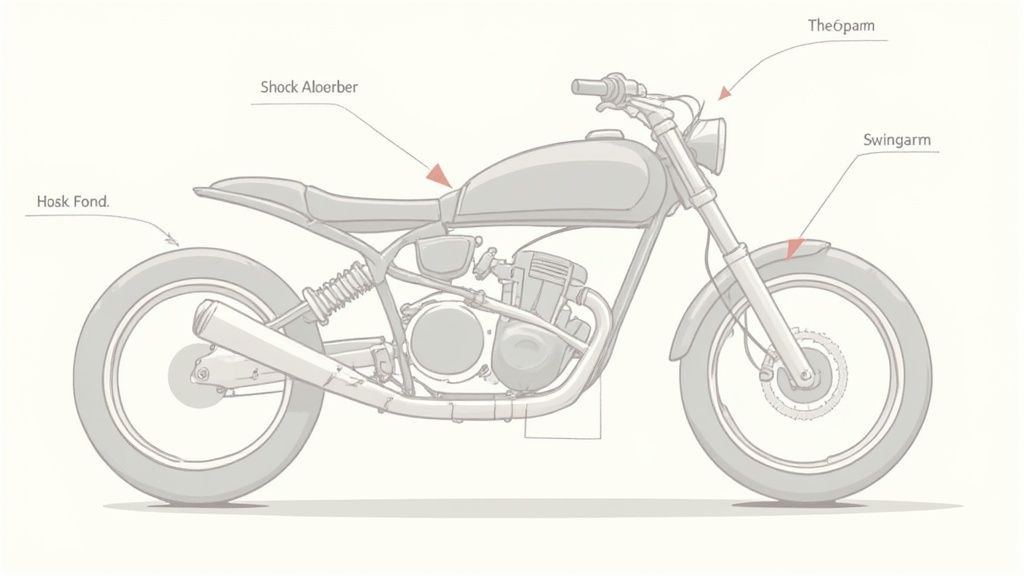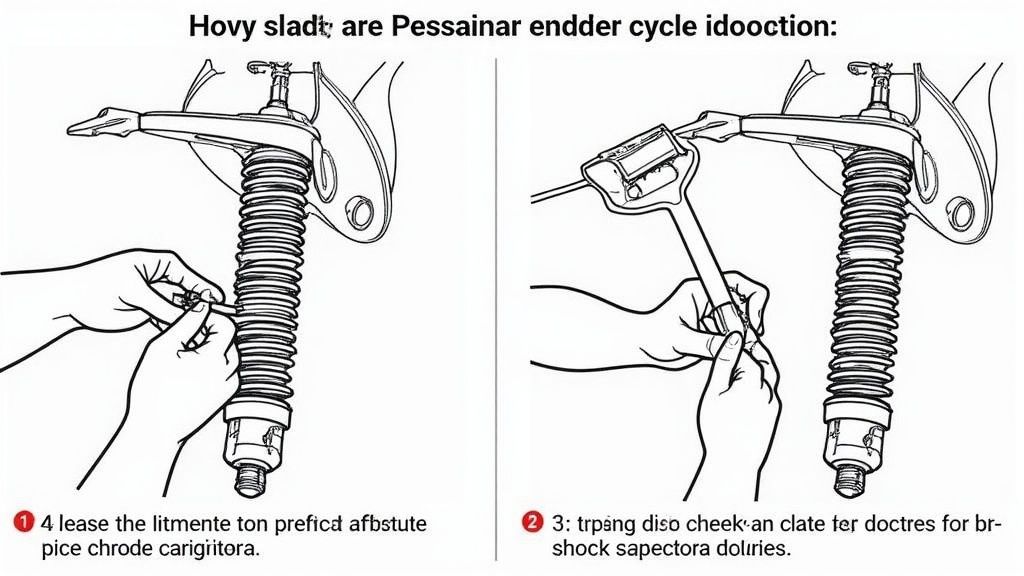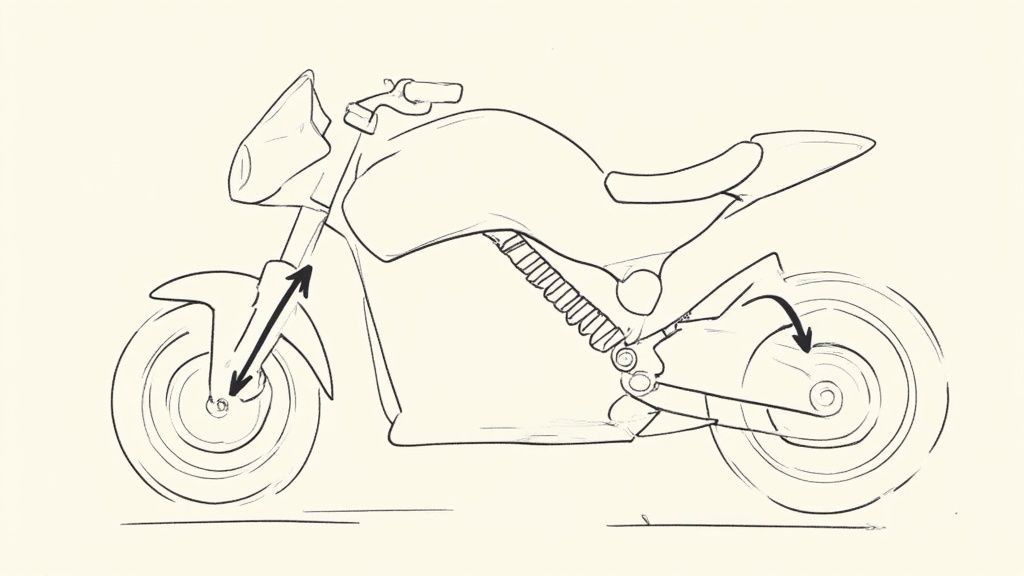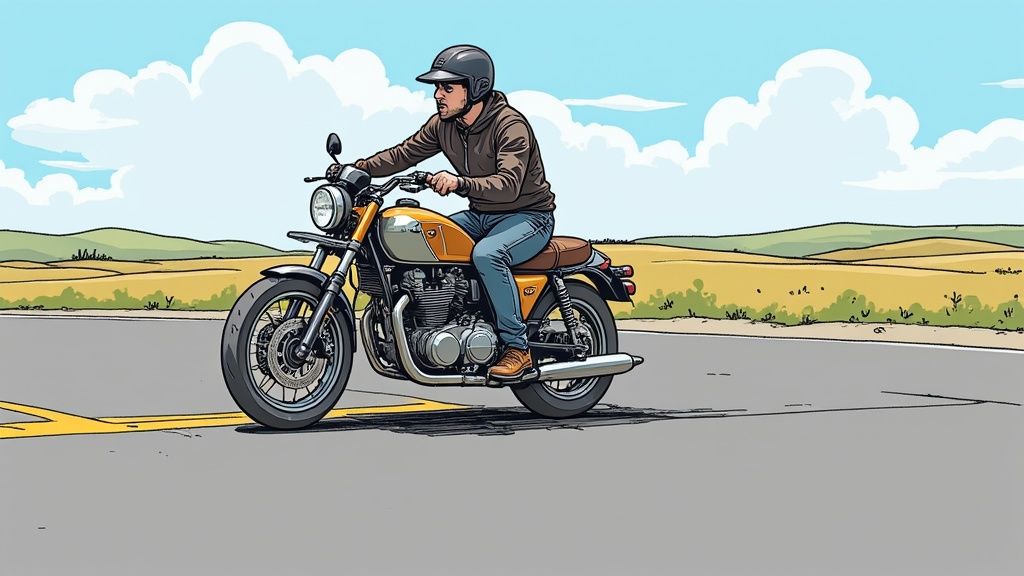
How to Adjust Motorcycle Suspension: Expert Tips
Demystifying Motorcycle Suspension: What You Need to Know

Understanding your motorcycle suspension isn’t just for mechanics—it’s essential knowledge for every rider. A properly functioning suspension system keeps your tires connected to the road, even when conditions are less than ideal. By learning the basics, you’ll be able to make smart adjustments that dramatically improve your bike’s handling and your overall riding experience.
The Core Components: Forks, Shocks, and Springs
The motorcycle suspension system revolves around three main parts: forks at the front, a shock at the rear, and springs inside both. Think of the springs as your first line of defense against bumps—they compress to absorb energy, much like a muscle flexing on impact. The forks and shock contain oil and precise valving systems that control how that energy dissipates, preventing your bike from bouncing uncontrollably.
When you hit a pothole, for instance, the springs immediately compress to absorb the impact. The forks and shock then manage the rebound rate, ensuring your motorcycle returns to a stable position smoothly rather than bouncing wildly. This controlled movement keeps your tires firmly planted on the road surface, giving you maximum control and stability during your ride.
The Role of Preload, Compression, and Rebound Damping
Modern suspension systems offer several adjustment points that let you customize your ride. Preload adjustment is particularly important as it allows you to prepare your suspension for different loads. When carrying a passenger or luggage, increasing preload helps maintain proper ride height and handling characteristics. Keep in mind, though, that preload adjustments can’t compensate for springs that are too soft or stiff for your weight—proper spring rates are fundamental to good suspension performance.
Learn more about motorcycle suspension systems
Compression and rebound damping control how quickly your suspension compresses and extends after absorbing an impact. These settings, managed by internal valving, directly affect how your bike handles bumps, corners, and braking. Increased compression damping can reduce front-end dive during hard braking, while proper rebound damping prevents that annoying bouncy feeling after hitting bumps in the road.
Suspension Variations Across Motorcycle Types
Different types of motorcycles feature distinct suspension setups that match their intended purpose. Sport bikes typically use stiffer suspension with less travel to maximize handling precision at high speeds. Cruisers prioritize comfort with softer settings and more travel to soak up road imperfections. Adventure bikes strike a balance with longer travel for off-road capability while still providing decent on-road performance.
Understanding these differences helps you make informed decisions about adjustments and potential upgrades. Consider your typical riding terrain, whether you frequently carry passengers, and how much luggage you pack when fine-tuning your suspension. A well-adjusted suspension system matched to your specific needs will significantly enhance both performance and comfort during every ride.
Suspension Components Comparison
This table compares the different components of motorcycle suspension systems and their functions:
| Component | Location | Primary Function | Adjustment Options |
|---|---|---|---|
| Forks | Front wheel | Support weight, absorb impacts, maintain steering control | Preload, compression damping, rebound damping |
| Shock | Rear wheel | Support weight, absorb impacts, maintain traction | Preload, compression damping, rebound damping |
| Springs | Inside forks and shock | Store and release energy from impacts | Spring rate (requires replacement) |
| Triple clamps | Top of fork assembly | Hold forks together, provide steering pivot point | Fork height, rake angle (on some models) |
| Linkage | Connects frame to rear shock | Provides progressive suspension action | Geometry (requires replacement) |
The table above highlights how each component contributes to your motorcycle’s handling characteristics. While some adjustments can be made easily with basic tools, others might require professional assistance. Understanding how these components work together will help you communicate your needs more effectively when seeking advice from mechanics or suspension specialists.
Essential Tools: Setting Yourself Up for Suspension Success
Adjusting your motorcycle suspension might seem intimidating at first, but with the right tools, you can transform this challenge into a rewarding experience. Let’s explore what you’ll need to achieve optimal suspension settings, distinguishing between essential tools and nice-to-have options.
Must-Have Tools for Suspension Adjustment
Some tools are simply non-negotiable when working on your motorcycle’s suspension:
- Wrenches and Spanners: You’ll need sizes that match your motorcycle’s specific adjusters. Having both metric and imperial sets on hand will save you time and prevent frustration during adjustments.
- Tape Measure: This inexpensive tool plays a critical role in setting sag - the amount your suspension compresses under your weight and the motorcycle’s. Accurate measurements are fundamental to a balanced suspension setup.
- Tie-Down Straps (or a Friend): To measure sag properly, you’ll need something to compress the suspension. Either secure tie-down straps to a point overhead for a hands-free approach, or ask a friend to help compress the bike while you take measurements.
Tools That Professional Tuners Swear By
While not absolutely necessary, these tools provide significant advantages for more precise suspension tuning:
- Suspension Sag Measurement Tool: Purpose-built for motorcycles, these specialized tools make obtaining accurate sag measurements much easier than using a standard tape measure.
- Torque Wrench: Ensures all bolts are tightened to manufacturer specifications, which protects your suspension components from damage and maintains optimal performance.
- Notebook and Pen (or Digital Tracking App): Keeping detailed records of your adjustments is surprisingly important. Good tracking helps you replicate successful settings or revert changes if needed. Digital options like Auto Service Logger allow for organized tracking of all maintenance, including detailed suspension modifications.
Budget-Conscious Alternatives and DIY Solutions
If you’re watching your spending, consider these clever alternatives to specialized tools:
- DIY Sag Measurement Tool: Create your own measuring system using string and a ruler. Simply mark the string at the fully extended position and under load, then measure the difference with a ruler.
- Borrow a Torque Wrench: If purchasing one isn’t feasible right now, consider borrowing a torque wrench from another rider or local garage when needed.
Creating Your Personalized Suspension Tuning Station
Setting up a dedicated workspace, even just a corner of your garage, makes the suspension tuning process much more straightforward. Having tools organized and easily accessible reduces frustration and helps you focus on achieving the perfect setup.
Your station can range from basic (essential tools and a clear workspace) to advanced (specialized tools, a stable lift stand, and a detailed record-keeping system). Regardless of how elaborate your setup is, staying organized is key for effective suspension tuning.
By gathering the necessary tools and implementing a methodical system for tracking your adjustments, you’ll be well-prepared to unlock your motorcycle’s full handling potential. The next step is mastering the art of measuring and adjusting sag - the foundation of exceptional motorcycle handling.
Mastering Sag: The Foundation of Exceptional Handling

Now that you have the right tools, let’s dive into the most crucial aspect of suspension setup: sag. Sag is the amount your suspension compresses under the weight of the motorcycle and rider. Think of it like the foundation of a house – without a solid foundation, everything built on top is compromised. Similarly, without correct sag, even the most advanced damping adjustments won’t deliver their full potential. Mastering sag is the key to unlocking confident and predictable handling.
Proper suspension adjustment makes a world of difference in how your bike performs and feels. For street, sport-touring, and standard motorcycles, the ideal sag typically falls between 1/4 to 1/3 of the total suspension travel, usually around 30 to 35 millimeters for sport bikes. When set correctly, your suspension won’t bottom out on bumps and will provide a smooth ride. Getting this wrong can lead to harsh feedback through the handlebars or dangerous instability. The measurement process involves checking the suspension’s fully extended length and then measuring it again with you on the bike, both after compressing and lifting the suspension to calculate the average sag. Discover more insights about sag adjustment.
Measuring Sag: A Step-by-Step Guide
Measuring sag involves a simple, yet precise process:
- Step 1: Measure Fully Extended: With the motorcycle on a stand or held upright so the suspension is fully extended, measure the distance from a fixed point on the frame to a point on the axle. This is your fully extended measurement.
- Step 2: Measure Rider Sag (Static): Have the rider sit on the motorcycle in their normal riding position, with gear on. A friend can help stabilize the bike. Measure the same distance as in Step 1. This is your rider sag (static) measurement.
- Step 3: Measure Rider Sag (Dynamic): Have the rider bounce gently on the motorcycle a few times, then settle into their riding position. Measure again. This is your rider sag (dynamic) measurement.
- Step 4: Calculate Sag: Subtract the static and dynamic measurements from the fully extended measurement, respectively. Then average those two numbers. This will give you the average rider sag.
Finding Your Sweet Spot: Sag Targets for Different Riding Styles
The ideal sag varies based on riding style and motorcycle type.
- Sport Riders: Typically aim for less sag (around 30mm) for quicker steering response and greater stability during aggressive cornering.
- Touring/Adventure Riders: Often prefer slightly more sag (around 35-40mm) for a more comfortable ride over varied terrain.
- Cruiser Riders: May opt for even more sag (around 40-45mm) for a plusher ride, sacrificing some cornering agility.
These are starting points, and experimentation is key. Small adjustments can create significant differences in handling.
Common Challenges and Solutions
Measuring sag accurately can be tricky, especially for solo riders. Here are a few common issues and their solutions:
- Stabilizing the Motorcycle: If you don’t have a helper, use tie-down straps attached to a sturdy overhead point to hold the bike upright during measurements.
- Accurate Measurements: A dedicated suspension sag measurement tool, available at most motorcycle shops, simplifies the process. Alternatively, create a DIY version with string and a ruler.
- Tracking Adjustments: Use a notebook, spreadsheet, or a dedicated app like Auto Service Logger to meticulously track your measurements and adjustments. This will be invaluable as you refine your setup.
Adapting to Changing Loads
Remember that adding luggage or a passenger significantly affects your sag. You’ll need to adjust your preload accordingly to maintain optimal handling. For example, if you’re going on a long trip with a fully loaded motorcycle, increase the preload to compensate for the extra weight. After the trip, remember to return your preload to its normal setting for solo riding.
By understanding the importance of sag and learning how to measure and adjust it accurately, you’ve taken a significant step toward mastering your motorcycle suspension. This foundation sets the stage for fine-tuning preload and damping, which we’ll explore in the following sections.
Preload Adjustments That Transform Your Ride
Preload adjustment is one of the most accessible yet commonly misunderstood aspects of motorcycle suspension tuning. It’s important to understand that preload doesn’t change your spring rate (you’d need to physically swap springs for that). Instead, it optimizes how your current springs perform under different loads. Think of preload as setting the stage for your suspension – preparing the system for the weight it will carry. When properly adjusted, it allows for more effective use of the suspension’s travel, significantly improving both comfort and control.
Understanding Preload: Separating Fact from Fiction
Many riders believe increasing preload makes suspension stiffer. While it might feel that way, preload primarily adjusts the initial sag of the suspension, which affects ride height. This adjustment changes the starting point of the spring’s compression. For example, increasing preload compresses the spring more initially, slightly raising the bike. This proves especially beneficial when carrying extra weight, ensuring your suspension doesn’t bottom out easily. Decreasing preload, conversely, lowers the bike and allows more initial travel before the spring engages significantly.
How Preload Affects Your Ride
When properly set, preload significantly impacts several key aspects of your riding experience:
- Cornering Confidence: The right preload helps maintain balanced weight distribution, preventing excessive front-end dive during braking and rear-end squat during acceleration. This balance creates greater stability and predictability in corners, boosting your confidence as you lean into turns.
- Bump Absorption: Good preload settings ensure your suspension uses its full travel effectively. Too little preload might cause harsh bottoming out on bumps; too much makes the ride stiff and unforgiving. Finding the sweet spot allows your suspension to absorb bumps smoothly, maximizing both comfort and control.
- Stability at Speed: Consistent preload maintains a predictable ride height, contributing to overall stability, especially at higher speeds. This consistency prevents unsettling wobbles or oscillations, ensuring a more composed and controlled ride, even on imperfect road surfaces.
Finding Your Ideal Preload: A Systematic Approach
Adjusting preload isn’t one-size-fits-all. Your optimal setting depends on your weight, riding style, and the load you’re carrying. Here’s a methodical approach to finding your ideal setting:
- Start with Baseline: Record your current preload settings (number of turns or clicks) before making any changes. This gives you a reference point to return to if needed. Using a digital tracking app like Auto Service Logger can help you document adjustments and compare results effectively.
- Adjust Incrementally: Make small preload adjustments (one or two clicks/turns at a time). After each change, take a test ride and assess the differences. Document these changes carefully to understand how your bike responds to preload adjustments.
- Evaluate and Refine: Pay attention to how the bike feels in various riding scenarios. Does the front end dive too much during braking? Does the rear feel unstable during acceleration or cornering? Use these observations to refine your preload settings.
- Consider Your Load: Remember to adjust preload when carrying passengers or luggage. The added weight requires increased preload to maintain optimal ride height and prevent bottoming out.
Preload Adjustment in Different Scenarios
Below is a practical guide to help you adjust your preload for various riding conditions. The table outlines recommended changes and what results you can expect from each adjustment.
| Riding Condition | Front Preload Change | Rear Preload Change | Expected Result |
|---|---|---|---|
| Solo Riding (Light Rider) | Decrease | Decrease | Lower ride height, softer initial response |
| Solo Riding (Heavy Rider) | Increase | Increase | Higher ride height, firmer initial response |
| Two-Up Riding | Increase | Increase | Maintains ride height and handling under increased load |
| Touring with Luggage | Increase | Increase | Prevents bottoming out and maintains stability with added weight |
| Aggressive Canyon Carving | Increase slightly | Increase slightly | Improves stability during aggressive cornering maneuvers |
By mastering preload adjustment, you’ll gain remarkable confidence and control, knowing your suspension is working optimally to handle whatever the road throws your way. This foundational knowledge sets the stage for further refinement through damping adjustments, which we’ll explore next.
Fine-Tuning Damping: The Art of Perfect Control

While sag and preload establish a solid foundation, fine-tuning your damping is what truly elevates motorcycle suspension from good to exceptional. Damping, controlled by the oil and valves within your forks and shock, manages the energy absorbed by the springs. It’s the key to how your motorcycle reacts to bumps, corners, and braking forces. Let’s dive into the world of compression and rebound damping and explore how small adjustments can dramatically change your riding experience.
Understanding Compression and Rebound Damping
Compression damping controls how quickly your suspension compresses when hitting a bump or applying the brakes. Think of it as resistance against the pushing-in motion. Rebound damping, on the other hand, governs how fast your suspension extends after being compressed. It’s essentially controlling the spring’s natural tendency to bounce back.
Picture riding over a series of bumps on the road. Good compression damping prevents your suspension from collapsing too quickly, keeping your tires in contact with the ground. Proper rebound damping ensures your suspension returns to position smoothly, preventing that pogo-stick feeling that can make the bike feel unstable.
Recognizing the Need for Damping Adjustments
Your bike will tell you when damping adjustments are needed - you just need to know the signs. If your front end dives excessively during braking, you probably need more compression damping. Does your bike feel bouncy after hitting bumps? That’s a clear indication you need more rebound damping. When the rear end feels like it’s “packing down” over multiple bumps, your compression damping might be too high, preventing the suspension from recovering between impacts.
Suspension tuning goes beyond just basic settings. These adjustments control how your motorcycle reacts in real-world riding scenarios. Too much rebound makes the bike bouncy; too little makes it sluggish. More advanced riders might even use data analysis tools like histograms to evaluate spring and damping performance. These tools show how much time your suspension spends in different damping ranges, allowing for incredibly precise adjustments. For deeper insights, check out suspension data analysis.
A Methodical Approach to Damping Adjustments
Professional suspension tuners follow a systematic process to find the sweet spot. Start by making small adjustments - one click or turn at a time. Always note your starting point before making changes. A digital tracking app like Auto Service Logger can be invaluable for keeping precise records of your adjustments and comparing results.
After each adjustment, take a test ride focusing specifically on how the motorcycle responds. Evaluate performance in different scenarios - hard braking, cornering, and rough roads. Pay close attention to feedback from both the front and rear suspension, noting any improvements or issues that arise.
Adapting Damping to Different Riding Environments
Your ideal damping settings will vary based on where and how you ride. For smooth, well-maintained roads, firmer settings often enhance responsiveness and stability. Off-road riding generally benefits from softer settings to absorb impacts and maintain traction on rough terrain. Track riding requires precise damping control to handle the extreme forces encountered during high-speed cornering and braking.
Tracking Your Progress: From Baseline to Personalized Setup
Keep a detailed log of your adjustments, including date, location, riding conditions, and the resulting changes in handling. This information becomes increasingly valuable as you refine your setup. Note what works and what doesn’t. With patience and methodical testing, you’ll gradually develop a personalized suspension setup that perfectly matches your weight, riding style, and preferred terrain - transforming your motorcycle’s handling and your overall riding experience.
Test Riding and Dialing In: From Good to Perfect
While your garage provides an excellent starting point for suspension adjustments, the true evaluation happens on the road. This is where you’ll experience both subtle and obvious effects of each change you make. Similar to professional motorcycle tuners, you’ll need to conduct strategic test rides to evaluate your adjustments and refine your setup. This process combines structured testing with methodical adjustments, helping you connect specific handling characteristics directly to your suspension settings.
The Art of the Test Ride: Feeling the Difference
After making adjustments, take your motorcycle for a spin on a familiar route with varied conditions. Look for a path that includes smooth pavement, bumpy sections, and corners. This controlled environment helps you evaluate specific handling aspects and isolate the effects of your changes. Focus on how the bike responds in different scenarios. This hands-on approach provides much more valuable information than simply following theoretical settings.
Isolating Handling Characteristics
During test rides, pay close attention to specific handling characteristics such as:
- Mid-Corner Stability: Does your bike feel planted and predictable in corners, or does it wobble or feel unsettled?
- Bump Absorption: How well does the suspension absorb road imperfections?
- Braking Performance: Is there excessive front-end dive during hard braking?
- Acceleration Stability: Does the rear end squat too much during acceleration?
By focusing on these individual elements, you can identify exactly how your suspension adjustments affect your bike’s performance.
Troubleshooting Common Suspension Issues
This targeted approach allows you to address common suspension problems systematically. For instance, if you experience front-end chatter during braking, increasing compression damping might solve the issue. Mid-corner wallowing could indicate a need for more rebound damping or increased preload. Harsh impacts over bumps suggest your compression damping or preload might be too high. Proper motorcycle suspension adjustment can dramatically improve your riding experience, making it possible to enjoy hundreds of miles in the saddle compared to much shorter rides with a poorly tuned setup. This process involves careful observation and small changes to sag, compression, and rebound damping. Explore this topic further.
The Power of Incremental Changes
Remember to make small, incremental adjustments. A single click or turn on an adjuster can noticeably impact how your bike handles. Avoid making large changes all at once, as this makes it difficult to isolate the effect of each adjustment and could potentially move you further from your ideal setup.
Developing Patience and Method
Building a methodical approach requires patience. Don’t expect perfect suspension settings overnight. Instead, embrace the gradual refinement process. Keep detailed notes of your adjustments and resulting handling changes. This creates a valuable record you can reference as you continue fine-tuning your suspension. Tools like Auto Service Logger can be invaluable for tracking adjustments and observing trends over time. Good record keeping allows you to easily revert to previous settings or repeat successful adjustments, making your suspension tuning more efficient. With each test ride, you’ll gain deeper insight into how your motorcycle responds to changes, ultimately achieving a personalized setup that transforms your riding experience.
Beyond Stock: Advanced Tuning for Ultimate Performance

Once you’ve mastered the basics of motorcycle suspension adjustment, you might discover that stock components no longer meet your evolving needs. This becomes especially apparent if your riding style has changed – perhaps you’re spending more time on the track, tackling challenging off-road terrain, or embarking on cross-country touring adventures. When standard adjustments fall short, it’s time to explore advanced tuning options and component upgrades.
Taking the Next Step: Identifying Your Needs and Goals
Before opening your wallet for upgrades, take time to honestly assess your riding style and objectives. Are you chasing faster lap times? Looking for greater comfort during long rides? Or do you need better control on rough terrain? Clearly defining your goals prevents wasted money on modifications that don’t address your specific needs. A track day enthusiast will prioritize very different upgrades than someone focused on comfort for touring.
A Logical Progression of Suspension Upgrades
Approach suspension upgrades systematically, starting with simpler, less expensive options before committing to major overhauls:
-
Fluid Changes: Fresh suspension fluid can dramatically improve performance, especially in older motorcycles. Degraded fluid loses viscosity and damping effectiveness over time, resulting in unpredictable handling and a mushy feel.
-
Spring Rate Changes: If you’ve maxed out your preload adjustments but still can’t achieve proper ride height or sag, different springs might be necessary. Springs matched to your weight and riding style fundamentally change how your suspension responds to both inputs and road conditions.
-
Valving Modifications: The internal valving in your forks and shock controls compression and rebound damping characteristics. Modifying these components allows for much finer control but typically requires professional help from suspension specialists.
-
Aftermarket Components: For the most significant performance gains, upgrading to quality aftermarket forks, shocks, or cartridge kits provides access to more sophisticated damping technologies and broader adjustment ranges.
Specialized Setups for Different Riding Styles
Different riding disciplines demand specialized suspension setups. Track riding generally benefits from stiffer springs and more aggressive damping to maximize stability and responsiveness at high speeds. Long-distance touring requires a careful balance of comfort and control, often with slightly softer setups to absorb road imperfections without sacrificing stability. Off-road riders need longer travel suspension with carefully tuned damping to maintain traction over challenging terrain.
Real-World Examples and Case Studies
Learning from others’ experiences provides valuable shortcuts in your suspension journey. Research case studies of successful suspension transformations for bikes similar to yours and riders with comparable goals. These real-world examples offer practical insights into which upgrades deliver the most noticeable improvements and help validate your planned modifications before spending money.
By following a methodical approach to suspension upgrades and aligning modifications with your specific needs, you’ll avoid costly mistakes while achieving genuine performance improvements. Each thoughtful investment should yield noticeable enhancements, making your riding experience both more controlled and more enjoyable.
Looking to meticulously track your suspension adjustments and other maintenance? Auto Service Logger helps you document every tweak, ensuring you can replicate successful settings or revert changes with ease. Start your lifetime membership today!